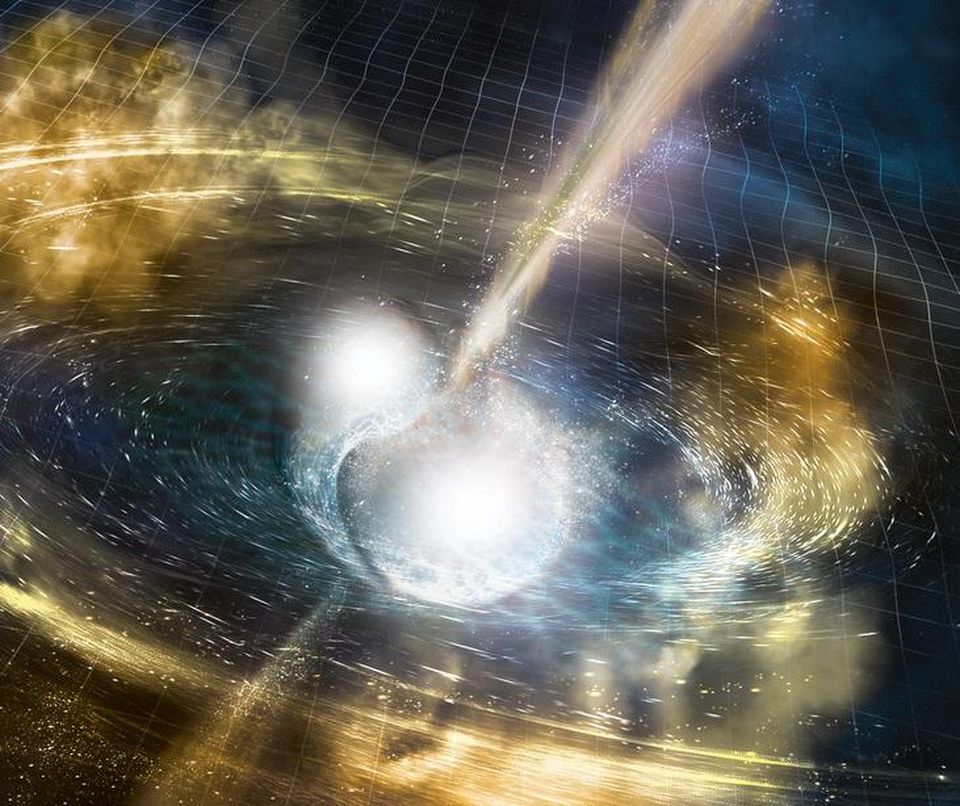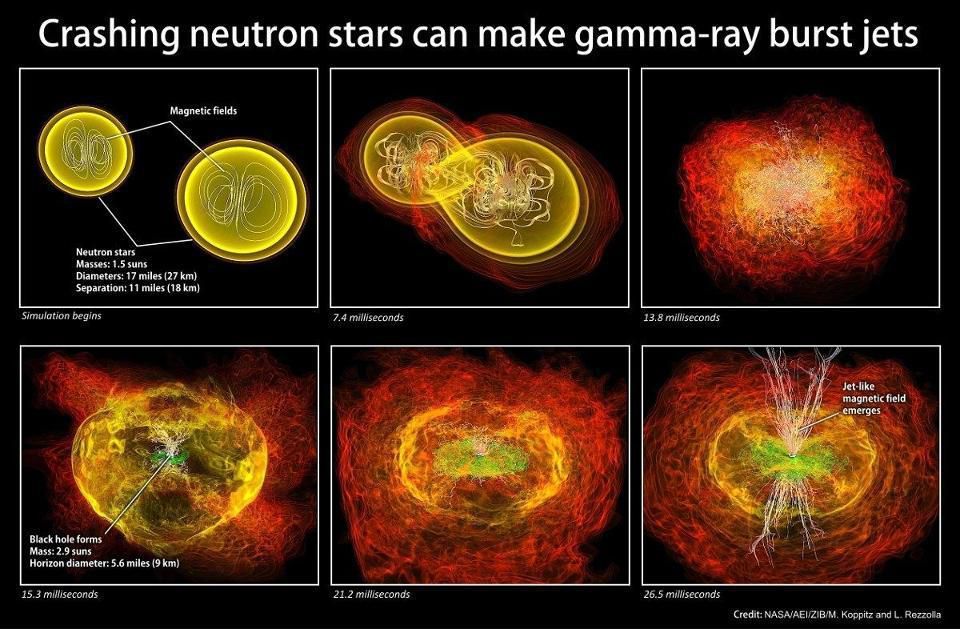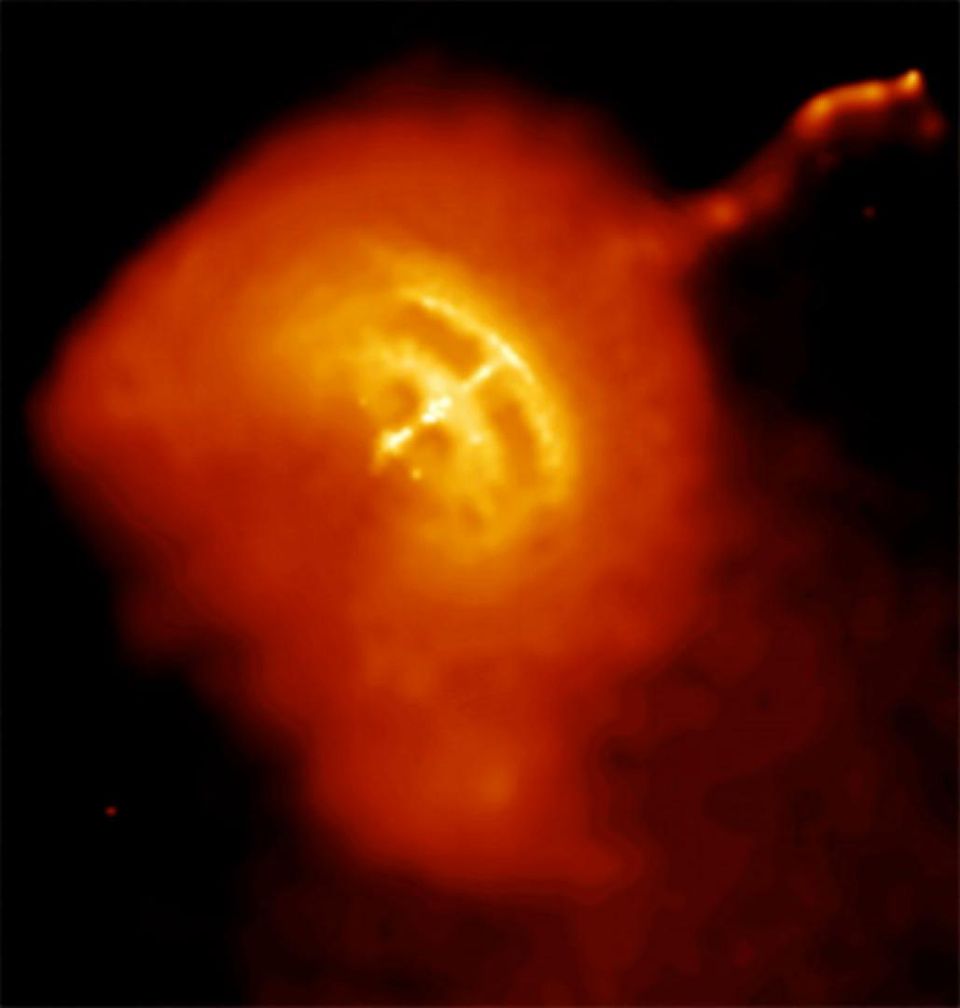 The merger of two neutron stars in the artist's view. Space-time lattice distortions depict gravitational waves emitted during a collision, and narrow rays are gamma-ray jets firing several seconds after gravitational waves (astronomers see them as gamma-ray flashes)
The merger of two neutron stars in the artist's view. Space-time lattice distortions depict gravitational waves emitted during a collision, and narrow rays are gamma-ray jets firing several seconds after gravitational waves (astronomers see them as gamma-ray flashes)On August 17, after traveling for 130 million years, a signal in the form of gravitational waves from two neutron stars moving towards each other in a spiral in the final stages of the merger
arrived on Earth . After the collision of the surfaces of two stars, the signal abruptly ended, and silence fell. And although these remains of stars with a diameter of perhaps only 20 km, moved at a speed of about 30% of the light, immediately after the collision we did not see anything. And only 1.7 seconds later, the first signal arrived: light in the form of gamma rays. Where does the delay come from? An excellent question asked by our reader:
Let us discuss the importance of the 1.7 sec difference between the arrival time of gravitational waves and the gamma-ray flash during the last event with neutron stars.
Let's see what we saw and try to understand where this delay comes from.
 Neutron stars during a fusion almost simultaneously can emit gravitational waves and electromagnetic signals. But the details of the merger are rather vague, and theoretical models do not exactly coincide with the observations.
Neutron stars during a fusion almost simultaneously can emit gravitational waves and electromagnetic signals. But the details of the merger are rather vague, and theoretical models do not exactly coincide with the observations.During the convergence of neutron stars before the merger, the gravitational waves become stronger. In contrast to the merger of black holes, there is no event horizon and singularity in the center. Neutron stars have a hard surface, 90% composed of neutrons, and 10% of the nuclei of other atoms (and electrons) located on the surface. It is predicted that in the collision of two such surfaces an uncontrolled nuclear reaction should occur, resulting in:
- The release of a huge amount of matter, many times the mass of Jupiter.
- The formation of a central collapsed object, most likely a black hole, in just a few hundred milliseconds, if we talk about the masses involved in the described event.
- Acceleration and release of material surrounding merging objects.
 We know that when two neutron stars merge, the simulation of which is shown in the picture, they emit gamma-ray jets and cause other electromagnetic phenomena. But the question of why the gamma-ray burst occurred 1.7 seconds after the gravitational fusion, has not yet been given a definite answer.
We know that when two neutron stars merge, the simulation of which is shown in the picture, they emit gamma-ray jets and cause other electromagnetic phenomena. But the question of why the gamma-ray burst occurred 1.7 seconds after the gravitational fusion, has not yet been given a definite answer.Thanks to observations from more than 70 telescopes and satellites in the spectra from gamma radiation to radio waves, we now know that it is in such processes that most of the heavy elements of the Periodic Table are generated. We know that as a result of the merger, most likely, a rapidly rotating neutron star appeared, which collapsed into a black hole a split second later. And we know that the first electromagnetic signal of this fusion - high-energy gamma rays - arrived 1.7 s after the end of the gravitational signals. On a time scale of 130 Ma, this means that the speeds of gravitational waves and light are equal with an error of 10
-15 .
 In the last moments of the merger, two neutron stars not only emit gravitational waves, but also undergo a catastrophic explosion, which responds along the entire electromagnetic spectrum. The difference in arrival between light and gravitational waves allows us to learn a lot about the universe.
In the last moments of the merger, two neutron stars not only emit gravitational waves, but also undergo a catastrophic explosion, which responds along the entire electromagnetic spectrum. The difference in arrival between light and gravitational waves allows us to learn a lot about the universe.But why are gamma rays late? Why did they not come at the same time as gravitational waves? There are two possible options:
- Gamma rays were emitted 1.7 s after the first contact of the surfaces of neutron stars.
- The gamma rays were emitted almost immediately, but were delayed during the passage of the matter surrounding the scene.
The catch is that the true answer may be a combination of both factors or an unlikely alternative, including exotic physics (a slight difference in the speed of gravitational and electromagnetic waves). Let's see how both options could be played.
 During the convergence in a spiral and the merging of two neutron stars, a huge amount of energy must be released, as well as the appearance of heavy elements, gravitational waves and electromagnetic signals.
During the convergence in a spiral and the merging of two neutron stars, a huge amount of energy must be released, as well as the appearance of heavy elements, gravitational waves and electromagnetic signals.Delay in the appearance of gamma radiation: when two neutron stars collide, they emit gamma rays. For 20 years now, the leading theory about the appearance of short flashes of gamma radiation in the sky has been the collision of neutron stars - and this theory has received tremendous confirmation when observing the GW170817 event. But where exactly do gamma rays appear?
- On the surface of neutron stars.
- Because of the collision of discarded matter with the surrounding matter.
- In the nuclei of neutron stars.
If one of the last two options is true, then the gamma rays should be delayed. The merger, the release of material, its collision with the surrounding matter, the emission of gamma rays by high-energy matter - all this takes time. If matter is located at a considerable distance from a neutron star, for example, tens or hundreds of thousands of kilometers, this would very simply explain the delay.
If gamma rays do not appear on the surface, but inside the colliding neutron stars, the delay should also be, because the light will take time to overcome the thickness of the star and come to the surface. Gravitational waves do not linger when passing through dense matter, and light is delayed. This would be very similar to our observations of a supernova in 1987, when neutrinos (which did not linger when passing through matter) arrived four hours before the first light signal, because the light was delayed, passing through a large amount of matter. Any of these explanations can cause gamma ray delays.
 The rapid flash of gamma rays, the cause of which has long been considered to be the fusion of neutron stars. A gas-rich environment can delay the arrival of a signal.
The rapid flash of gamma rays, the cause of which has long been considered to be the fusion of neutron stars. A gas-rich environment can delay the arrival of a signal.Instant emission but delayed arrival: another basic option. Even if gamma rays are emitted from the rhinestone, they need to go through the richly matter surrounding neutron star. And it will be rich in matter, because due to the very high velocity of neutron stars and the enormous magnetic fields emitted by them, the material will necessarily be thrown into space during their convergence and fusion. Their dance together lasts a very long time, so a lot of matter must gather around them, through which the light must pass before it reaches our eyes. Is there enough matter to hold the light at 1.7 s? It can be so much - and this is another one of the main options.
 Pulsar in Sails , like all pulsars, is an example of the corpse of a neutron star. Quite often, it is thus surrounded by gas and matter, and the substance surrounding the neutron stars that participated in GW170817 may be responsible for the delay of light.
Pulsar in Sails , like all pulsars, is an example of the corpse of a neutron star. Quite often, it is thus surrounded by gas and matter, and the substance surrounding the neutron stars that participated in GW170817 may be responsible for the delay of light.To get the correct answer, it is necessary to study the variants of events for different combinations of masses: total mass up to 2.5 solar (as a result, you get a stable neutron star); from 2.5 to 3 solar masses (as in the event that we saw - a neutron star appears temporarily, then turning into a black hole); over 3 solar masses (a black hole appears immediately); as well as measure light signals. We can learn more if we determine in advance the beginning of the phase of the spiral approach and can send the tools to the desired point some time before the merge. Since LIGO / Virgo and other gravitational wave detectors have earned and become more sensitive, these actions will get better and better.
 Remnant supernova 1987a, located in the Large Magellanic Cloud, 165,000 light-years. The fact that neutrinos arrived many hours before the first light signal told us more about the time it takes for light to penetrate supernova layers than about the speed of a neutrino that is indistinguishable from the speed of light.
Remnant supernova 1987a, located in the Large Magellanic Cloud, 165,000 light-years. The fact that neutrinos arrived many hours before the first light signal told us more about the time it takes for light to penetrate supernova layers than about the speed of a neutrino that is indistinguishable from the speed of light.Exotic ideas, such as different speeds in gravity and light, are completely unnecessary to explain this observation. A delay of 1.7 s can be explained using several ideas that do not depart from traditional physics. Gravitational waves simply pass through matter without resistance, and light interacts with it, being an electromagnetic wave, and this can lead to completely different results. Compared to supernovae, the gamma rays generating neutron stars are tiny, so for a complete and accurate description of this effect, it will be necessary to understand well how this cataclysm takes place at very short time intervals. Theorists race to understand what is happening, we already have the data. And the next such event can change everything.
Ethan Siegel - astrophysicist, popularizer of science, blog Starts With A Bang! He wrote the books Beyond The Galaxy , and Treknologiya: Star Trek Science [ Treknology ].